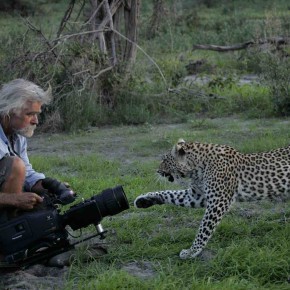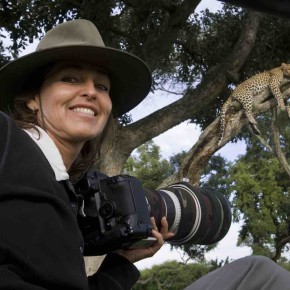Lori Robinson's Blog, page 8
March 8, 2018
Best NGOs For Wildlife, Part 2
As promised, here is part 2 of my list of the best 40 NGOs working to save wildlife and wild lands all over the world. There are many organizations doing great work saving wild, but I have chosen those NGOs for wildlife that I am familiar with, or that I believe deserve more attention for the wonderful work they are doing.
Want to help but you have no extra money for donations this year? Do this-
It won’t cost you an extra cent.
Use our Amazon Link everytime you shop and a portion of your purchase will go to Saving Wild’s favorite wildlife NGOs.
Every time you shop at Amazon, use this link:
For Part 1 of the best NGOs for wildlife that won’t waste your money, go here.
Here is Part 2:
SAVING OCEAN SPECIES
Ric O’Barry’s Dolphin Project (Dolphins)
Ric O’Barry’s Dolphin Project (not to be confused with other organizations with a similar name) was founded on Earthday 1970 with the aim to stop dolphin slaughter and exploitation around the world after ‘Flipper’ committed suicide in his arms. Ric O’Barry has pioneered the re-adaptation & release of captive dolphins into the wild.
Oceana
The world’s oceans are in trouble, and this organization works with companies and legislators to bring about more sustainable practices for the long-term health of the ocean and its creatures.
Sea Shepherd Conservation Society
Sea Shepherd uses innovative direct-action tactics to investigate, document, and take action when necessary to expose and confront the destruction of habitat and slaughter of wildlife in the world’s oceans in order to conserve and protect ecosystems and species.
SAVING SPECIFIC SPECIES
Painted Dog Conservation (African Wild Dog)
Painted dogs, or african wild dogs, are among Africa’s most endangered species with only 3,000 – 5,000 left. Zimbabwe is home to one of the last strongholds of the species and PDC works to educate the local communities about the importance and beauty of this iconic species.
**SavingWild.com has partnered with PDC to sponsor school children to go through their Wild School program.
North American Bear Center (Black Bears)
All eight bear species around the world are listed as vulnerable, threatened or endangered. The Bear Center is dedicated to replacing misconceptions with education and scientific facts to conserve bear habitat, stop poaching for bear body parts, rehabilitate injured and orphaned bears back to the wild, and implement methods to reduce conflict between humans and bears.
The Cougar Fund (Mountain Lions)
The Cougar Fund protects the cougar – also known as a mountain lion, puma, and panther – and other carnivores throughout the Americas by educating children and adults on their value, and by monitoring state policies and advocating for management based on sound science, to assure a lasting place for these creatures.
Australian Society for Kangaroos
The Australian Society for Kangaroos works to educate the public about the iconic, cultural, spiritual and economical value of all species of kangaroos and wallabies who are victims of the world’s largest land-based wildlife massacre.
National Audubon Society (Birds)
Audubon’s mission is to conserve and restore natural ecosystems, focusing on birds, other wildlife, and their habitats for the benefit of humanity and the earth’s biological diversity.
Free the Bears (Asian Bears used for Bile Farming)
Started by animal advocate and grandmother Mary Hutton after watching a current affairs TV program in Perth about the bile farms with captive Asiatic bears, the mission of this organization is to protect, preserve and enrich the lives of bears throughout the world.
Project Coyote works to change negative attitudes toward coyotes, wolves and other native American carnivores by replacing ignorance and fear with understanding, respect and appreciation.
CAN’T DECIDE WHICH NGOs FOR WILDLIFE TO GIVE TO?
NOT SURE WHO TO GIVE TO, LET US DECIDE. DONATE TO SAVING WILD AND WE WILL POOL YOUR MONEY WITH OTHER DONORS AND MY PERSONAL $1,500 GIVING BUDGET TO DISTRIBUTE TO OUR FAVORITE ORGANIZATIONS WITH THE MOST NEED.
NO AMOUNT IS TOO SMALL.
DONATE NOW:

WILDLIFE TRAFFICKING/POACHING
International Anti-Poaching Foundation
The IAPF has a structured approach to conservation, employing the relevant tactics and technology to defend wildlife from the ever increasing threat of poaching within protected areas. Anti-poaching however is only a portion of the conservation solution. To be a part of successful projects, the IAPF works alongside partners who specialise in community engagement and development, research and development, wildlife rescue and biodiversity management.
Wild Aid (Illegal Wildlife Trade)
Wild Aid is the only organization focused on reducing the demand for wildlife parts and products, with the strong and simple message: when the buying stops, the killing can too. Their mission is to end illegal wildlife trade.
SAVING WILD PLACES FOR WILDLIFE
Yellowstone to Yukon Conservation Initiative (Wildlife Corridors)
A joint United States and Canada Initiative, it is recognized as one of the planet’s leading mountain conservation initiatives to preserve and maintain the wildlife, native plants, wilderness and natural processes of the mountainous region from Yellowstone National Park to the Yukon Territory.
Working in Africa, their mission is to find the right formula of conservation, communities and commerce that would make a lasting, sustainable difference to the world’s iconic wildlife and wildernesses.
The Alliance brings its more than 1,100 member land trusts together — and increases each one’s success by advocating for the policies and incentives that it takes to save millions of acres every year.
SAVING ALL AFRICAN WILDLIFE
African Wildlife Conservation Fund
The African Wildlife Conservation Fund promotes the long-term sustainability of healthy wildlife populations via research and educational partnerships with landowners and community members, natural resource managers, conservationists, and governments in Africa.
Wildlife Direct is a Kenya and US registered organization founded and chaired by African conservationist Dr. Richard Leakey, who is credited with putting an end to the elephant slaughter in Kenya in the 1980s. Established in 2006 Wildlife Direct provides support to conservationists in Africa directly on the ground via the use of blogs, which enables anybody, anywhere to play a direct and interactive role in the survival of some of the world’s most precious species.
Based in Britain with twenty-two years experience initiating and funding conservation, community development and environmental education programs across Africa, Tusk has raised over $30 million for a wide range of projects across the African continent. Their annual conservation awards, presented by Prince William, highlight inspirational conservation work in Africa.
SAVING INDIA’S WILDLIFE
A great organization focused on India’s wildlife and wild places by providing reliable information and the tools needed to campaign effectively. They are working to protect elephants, and tigers, as well as fighting against plastic litter.
Note: Charity Navigator provides an important service to donors interested in U.S. charities, but it is unable to capture the entire picture of the work and structure of some international wildlife organizations. Charity Navigator itself states: “We do not recommend using our ratings as the only factor in deciding whether to support a particular organization.”
I hope you are finding these lists of the best NGOs for wildlife helpful when choosing where you can be most effective with your giving. If you missed part 1 check it out now.
Love,
Lori
The post Best NGOs For Wildlife, Part 2 appeared first on .
Best 40 Wildlife Organizations that Won’t Waste Your $$$
Here is Part 1 of the list of my current favorite 40 wildlife organizations to donate to. I update this post throughout the year so check back whenever you are deciding where to give your wildlife donations.
SAVING ELEPHANTS
David Sheldrick Wildlife Trust
For orphaned elephants and rhinos it doesn’t get better than this wildlife organization. With an orphanage in Nairobi and a wild release and anti-poaching program in Kenya’s largest national Park, Tsavo, this organization is currently overwhelmed with baby-orphaned elephants as a result of the escalating poaching crisis. Learn more about the remarkable woman who runs this place by reading her wonderful memoir.
Save the Elephants
Iain Douglas-Hamilton’s research on wild elephant populations in Northern Kenya has taught the world much about elephant behavior, and migrating patterns. His wildlife organization, ‘Save the Elephants’ is focused on stopping poachers, thwarting traffickers and ending demand for ivory (most recently using educational programs in China where it is desperately needed).
Performing Animal Welfare Society
PAWS is at the forefront of efforts to rescue and provide appropriate, humane sanctuary for animals who have been the victims of the exotic and performing animal trades. Started by an animal trainer for the movie industry turned animal activist, PAWS focuses on Elephants but has also rescued bears, tigers, monkeys and other animals from the abusive life of entertainment.
SAVING WILD CATS
Cheetah Conservation Fund
Dr. Markers Cheetah Conservation Fund is a model for other wildlife organizations with her pioneering work engaging communities in Namibia to help her protect cheetah. Find out more about Dr. Marker in an interview she did with SavingWild.com.
Panthera
Dedicated to conserving the world’s 36 species of wild cats, Panthera partners with local and international scientific institutions, communities, non-governmental organizations and government agencies to conserve endangered wild cats, including tigers, lions, jaguars, and snow leopards around the world.
Small Cat Conservation Alliance
The SCCA works with partners and organizations around the world reducing and mitigating threats to the worlds thirty one species of small wild cats.
BEST WILDLIFE ORGANIZATIONS SAVING GREAT APES
Save the Chimps
Established in1997 by Carole Noon and 21 chimpanzees, Save the Chimps has grown to be the worlds largest chimpanzee sanctuary providing permanent care for 300 chimpanzees rescued from research laboratories, the entertainment industry, and the pet trade.
Recommended reading- Opening Doors: Carole Noon and Her Dream to Save the Chimps, by Gary Ferguson.
Non-Human Rights Project
The only organization working toward actual LEGAL rights for non-human species. Their mission: to change the common law status of at least some nonhuman animals from mere “things,” which lack the capacity to possess any legal right, to “persons,” who possess such fundamental rights as bodily integrity and bodily liberty. What this organization is fighting for, if achieved, will be a game changer for all of us working for animal welfare.
Great Apes Survival Partnership
GRASP is an innovative and ambitious partnership comprised of great ape range states faced with an immediate challenge: to lift the threat of imminent extinction faced by gorillas, chimpanzees, bonobos and orangutans across their ranges in Equatorial Africa and Southeast Asia.
Lola ya Bonobos
Lola ya Bonobo is the world’s only organization to provide lifetime care to orphaned bonobos (the least known of the great apes). At the sanctuary the bonobos recover from the physical and psychological trauma suffered from being torn from their mothers, their families, and their natural habitat, The Democratic Republic of Congo, the only country with wild bonobos.
Recommende reading: the delightful memoir, Bonobo Handshake, by Vanessa Woods who spent years working at Lola ya Bonobo sanctuary.
Ngamba Island
This 100-acre sanctuary in Uganda rescues orphaned and abused chimps from the bushmeat, entertainment and pet trade industries. Through their ‘adopt a chimp’ program you can support one of the 48 chimps currently living there.
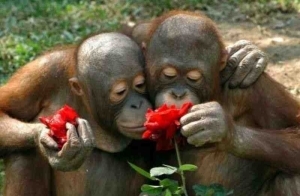 Orphaned orangutans appreciating flowers.
Orphaned orangutans appreciating flowers.Save The Orangutan
Save the Orangutan has launched a Forest Program with the purpose of preserving and restoring the orangutans’ natural habitat. By supporting SOS Borneo, you help ensure that orangutans can continue to roam freely in the treetops of Borneo.
I hope you are finding this list of best wildlife organizations to donate to useful.
Can’t decide who to give to?
Simply use our Amazon Link everytime you shop and a portion of your purchase will go to Saving Wild’s favorite wildlife organizations.
Every time you shop at Amazon, use this link:
SAVING WILDLIFE WORLDWIDE
Center for Biological Diversity
Because the loss of biodiversity impoverishes society, the Center for Biological Diversity uses science, law, and creative media to protect the lands, waters, and climate that all species need to survive. An impressive ninety-three percent of their lawsuits have resulted in favorable outcomes for endangered species.
14. Animal Defenders International
Animal Defenders International (ADI) was founded in 1990. With offices in Los Angeles, London and Bogota, ADI educates and campaigns across the globe on animals in entertainment and other industries. One of the busiest and most effective organizations I know of but I find their website to be confusing and a turn off to someone looking to get involved.
International Fund for Animal Welfare
Whether it’s working to end whaling, poaching, or seal hunts this wildlife organization seems to have no boundaries for its mission to save individual animals, animal populations and habitats all over the world. Founded in1969 and now with projects in more than 40 countries including China, the IFAW provides hands-on assistance to animals in need, whether it’s dogs and cats, wildlife and livestock, or rescuing animals in the wake of disasters.
Defenders of Wildlife
Defenders’ approach is direct and straightforward – they “protect and restore imperiled species throughout North America by transforming policies and institutions and promoting innovative solutions” –making a lasting difference for wildlife and its habitats.
Born Free
Born Free takes ‘front line’ action worldwide, sending emergency teams to rescue vulnerable animals from appalling lives of misery in tiny cages and move them to spacious bush sanctuaries.
Peta
Peta’s statement that “Animals are not ours to eat, wear, experiment on, use for entertainment, or abuse in any way,” says it all. Considered by some to be radical in their approach they are on this list because I admire their courage to push the limits for the animal causes they are focused on whether it be criticizing the movie and commercial industry for continuing to use chimps as actors, designing explicit ads for anti-fur campaigns, or releasing undercover photos from factory farms, Peta is great at shedding light on some of the toughest areas of animal abuse.
Wildlife Conservation Network
WCN saves endangered species in 24 countries around the world by supporting 14 independent wildlife conservationists working with different wildlife species. They also produce an annual fall conference in San Francisco where supporters can meet and hear from WCN’s conservationists and learn about their wildlife organizations.
South Florida Wildlife Center
Based in Fort Lauderdale, Florida in the USA, this Wildlife Center is the countries highest volume wildlife hospital. Each year they treat over 12,000 animals of more than 250 species. An affiliate of The Humane Society of the United States, the center has been protecting South Florida’s biodiversity, transforming wildlife rehabilitation and saving lives for nearly 50 years. SFWC provides emergency rescue services, diagnostics, surgical and other veterinary treatment, recovery habitats, orphan rearing and expert rehabilitative care.
For part 2 of my favorite 40 Wildlife NGOs use this link.
The post Best 40 Wildlife Organizations that Won’t Waste Your $$$ appeared first on .
February 24, 2018
Dereck and Beverly Joubert- A Love Story
Seconds after meeting conservationist extraordinaire Beverly Joubert for the first time, she holds my hand as if we are BFF’s. I found her to be generous, kind, warm and attentive -someone I would want as a best friend forever.
She is also, surprising because of her petite and feminine characteristics, a woman who has no problem living without things most people call necessities, like electricity and running water, and spending days in the relentless Botswana sun surrounded by animals that could easily kill her, while working alongside her husband Dereck Joubert as National Geographic Explorers in Residence.
One of conservations most hard working and effective couples; Dereck and Beverly Joubert have a wonderful love story. Both South Africans, they met in high school, and fell in love through their mutual love of wild places and wildlife and their desire to protect them.
During the past 30 years they have made 25 films, and written 11 books, six scientific papers, and many articles for National Geographic magazine, all focusing on large predator key stone species. Their body of work has resulted in eight Emmys, a Peabody, the World Ecology Award, and in 2009 they were inducted into the American Academy of Achievement.
Of all the conservationists I have met over the years, Beverly Joubert is perhaps the one I would most like to trade lives with, despite, as you will learn in this interview, the sacrifices and unusually tough circumstances her life’s work requires.
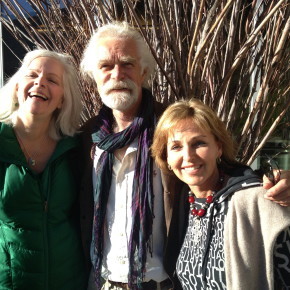 Lori with the Jouberts
Lori with the Jouberts
SAVING WILD’S INTERVIEW WITH BEVERLY JOUBERT
How did you decide to devote your life to wildlife conservation?
As a teenager I was troubled by what humans were doing to each other and other creatures and I wanted the world to change. I met Dereck in the late seventies and found a kindred soul. We started making wildlife films in the early eighties and began to understand the extent to which the wilderness areas we were filming were being destroyed. That’s when we realized we were more than wildlife filmmakers. Our role was first and foremost to be conservationists.
What sacrifices have you made while becoming some of the worlds best conservation filmmakers?
Sometimes I wonder if Dereck and I appear to be aloof and abnormal because we are often on our own for months at a time filming a project. One film took 7 years to make, and the one about leopards took 5 years. During those times we lose contact with close friends, family, and the outside world.
We also made a decision not to have children. Our films are filled with the passion we would have given to a family, had we created one. It would have been impossible to do both but it has been a worthwhile sacrifice.
When we are in the wilderness we don’t have ‘luxuries’ – running hot and cold water, clean drinking water, fresh food (which would require a fridge), communication devices, or sophisticated tools to fix the inevitable breakdowns with our vehicle and bush plane. In the bush things like getting 7 hours of sleep a night, staying dry and cool, avoiding insect bites and being able to shower and clean our clothes become the luxuries!
Working in the wilderness we are completely exposed to the elements and are often in remote areas where a quick exit is not an option. A major storm can interrupt our lives and, when we are in a small light aircraft, become life-threatening.
All this makes our lives harder, but without experiencing the hardships we could not truly understand the wilderness, be as connected to it as we are, or become emotionally moved by it. And that makes our films more powerful.
Dereck and Beverly Joubert are one of twenty amazing conservations featured in my newest book, Wild Lives.
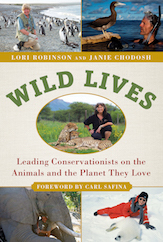
You have said that in the last 50 years Africa has lost 90-95% of its large predators. They are now extinct in 26 of Africa’s 54 countries. How do you stay inspired despite the increasing negative issues we face protecting wildlife and wild places?
Getting to know individual characters like the little leopard we followed for over 5 years for our movie ‘Eye of the Leopard’ inspires us to speak out on behalf of wildlife. We have become ambassadors for animals out of necessity and feel we must protect the last remaining ones in the few countries where they still exist. That, the urgency of the situation and knowing all that could be lost also keeps us inspired to do more.
Why should people care about saving wild places and wildlife?
Wildlife and wild places are our greatest natural treasures – priceless and irreplaceable.
We live in a connected world, and with a collective heart and mind we can, and must, end the destruction. We cannot let humanity become like a deadly fungus that exterminates everything for lust and greed. While there is hope, all of us must continue to fight to protect wild places and wild animals.
Where do Dereck and Beverly Joubert find hope?
We are optimists at heart. If we weren’t, we couldn’t continue.
It takes a special kind of person to devote their lives to helping wild places and wildlife. What qualities or characteristics do you two possess that has helped you do this work and be so successful at it?
I think compassion, curiosity and a sense of adventure are all important qualities we possess.
Being tenacious, never giving up no matter what it takes, has also helped us. Dereck and I are never scared to take on huge issues. As the issues get bigger, so do our ideas, projects and solutions.
We may get disappointed in ourselves or by an outcome but we never let this disappointment slow us down. Rather, it drives us on. We won’t stop until we have done everything in our power to conserve Africa’s wilderness for future generations.
It also helps to be the type of person who has a set of ethics and sticks to them, even when times get tough. If you want to set an example and inspire others to do the same, you must know what you stand for and live and breathe it.
We are both creative, which helps us communicate with our audiences by pushing the boundaries with our films and conservation solutions.
From all that you have accomplished, what are you most proud of?
One of our main goals is to turn ex-hunting lands into nature reserves so they will be protected in the future. We have had a number of successes on this front. The Selinda reserve was heavily hunted and poached eight years ago. We shut down hunting there in 2006 and the area is now teeming with wildlife.
We are equally proud of the close relationships we have been able to develop with wild animals.
By giving them total respect, we have been accepted into their world, which is an immense privilege. Our work with Legadema, the little leopard I mentioned earlier changed our lives and turned us into Ambassadors for Cats, resulting in the birth of the Big Cats Initiative with National Geographic.
Hearing from people all over the world that our work has inspired them to be ambassadors for the natural world is equally as rewarding for us.
**For the entire story of Dereck and Beverly Joubert get your copy of Wild Lives.
The post Dereck and Beverly Joubert- A Love Story appeared first on .
February 11, 2018
7 Surprising Benefits You Will Gain from De-cluttering Your Life
De-cluttering your life is the self-help du jour. And for good reason.
Whether you are just thinking about de-cluttering your life, or have embraced the process, I can tell you from experience that it will benefit you and the planet in multiple and surprising ways.
I’ve always loved the feeling of cleaning out long overlooked drawers, giving away clothes I don’t wear to my sisters, or selling furniture that I no longer love. It’s a feel-good act to clear out unwanted, unused, and unloved stuff from your life.
 Dining & Reading room in my California home, post de-clutter
Dining & Reading room in my California home, post de-clutterI purposely live in a small home because I don’t like having to furnish large spaces I rarely use or maintain things I don’t need. And, the small space keeps me disciplined about not re-accumulating.
De-cluttering Done Right
To gain the most reward from your de-cluttering process you need to do it right. If you simply fill your trash-can with all the things that you no longer want you will not reap the blessings available from the process.
To really benefit you and the planet, de-cluttering has to be done with an awareness about the items you will get rid of.
The planet’s resources and the many people involved in producing the shirt, chair, or package of food in your home demands reverence. When you decide to get rid of something it means you can find a better place for it to be back in the world with someone who will use it, love it, and want it. Friends and relatives, consignment shops, and donation outlets are all good candidates for reusing the things you no longer want to keep.
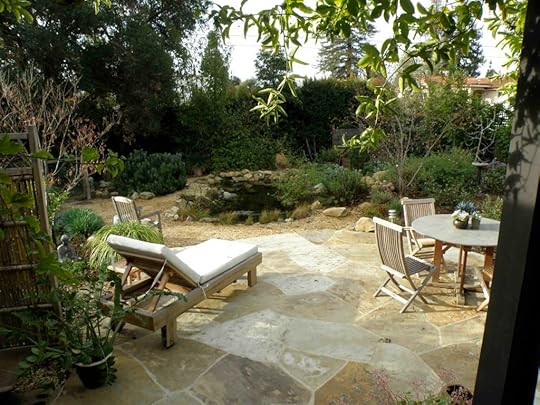 My California back garden contains only things I absolutely Love. De-cluttering does not have to mean empty.
My California back garden contains only things I absolutely Love. De-cluttering does not have to mean empty.7 ways de-cluttering will help you and the planet
It makes you realize you actually feel better when you are surrounded by less stuff. There is less to maintain, worry about, and think about. When the spaces around you are free of clutter, your internal space is also freer. Free to dream. Free to create. Free to relax.
Once you get rid of things that no longer serve you, you are less likely to bring more things back into your home. You are more aware of re-cluttering and undoing all the work you did to un-clutter in the first place. So, you naturally start to consume less.
You become a more conscious consumer. Conscious consumption saves you money and time and is one of the best ways to heal the planet. When you do buy something it’s because you need and love it.
The act of de-cluttering will spill over into other parts of your life. After finishing the de-cluttering of my home spaces, I went on to clean up my email inbox, my i-photo file, and my computer desktop.
De-cluttering becomes a metaphor for living more simply. Simplifying can be applied to every area of your life. I even de-cluttered my eating habits. I realized I don’t need as much variety in my cupboards, and that eating more simple meals is healthier. My body and the planet both benefit.
De-cluttering is a gift to the next generation. Not only are you modeling a simple, less consumer-oriented lifestyle for younger family members, you are also ensuring they don’t have a huge mess of things to organize, and get rid of when you die.
Most people feel a deep sense of sadness about the state of the planet, and powerless about changing it. Perhaps the most surprising gift that comes from the act of de-cluttering is that it’s an antidote for this kind of ecological despair. De-cluttering our life allows us to take a stand and do something tangible towards our goal of a more sustainable planet.
Resources to support you in de-cluttering your life
Best selling phenomena, Marie Kondo’s book, The Life-Changing Magic of Tidying Up
The Gentle Art of Swedish Death Cleaning, by Margareta Magnusson
I would love to hear from you in the comment section below about your journey with de-cluttering your life.
The post 7 Surprising Benefits You Will Gain from De-cluttering Your Life appeared first on .
November 8, 2017
Overwhelmed by All the Changes You Want for the Planet?
If you make a list of all the ways you want to help the planet, how long will your list be?
Global warming, poaching, species extinction, habitat loss, animal abuse, factory farming, the list of things we want to change is long.
It’s easy to feel overwhelmed. And when we are overwhelmed, it’s easy to feel stuck. That means we end up doing nothing.
But, now more than ever, the planet needs you, me and every one of us. The changes we want for the planet will not happen without each of us doing our part.
So how can we defeat feeling overwhelmed, stuck and powerless? How can we stay inspired?
First, remember that saving the planet isn’t easy! We want it to be, but it isn’t. If we are unrealistic with our expectations for change, we often end up feeling disappointed.
Second, follow, listen to and learn from people like the heroes in my books, Saving Wild, and Wild Lives. These are people who never give up. Adopt them as mentors.
Third, focus on the positive. Remind yourself that change is possible by celebrating what has been achieved.

But most important of all, begin. Anywhere. Then, keep going. And, never give up! The planet needs you!
Use this link each and every time you shop on Amazon. A percentage of your sale will go to the most effective people and organizations helping wildlife across the planet. 
The post Overwhelmed by All the Changes You Want for the Planet? appeared first on .
October 23, 2017
Conservation’s Dog Heroes
Dogs are amazing. They are lovable, loyal, and protective. And, it turns out, heroes of conservation.
Working Dogs for Conservation (WD4C) loves bad dogs – the obsessive high-energy kind. Of the approximately one million dogs euthanized in shelters across the country each year, Megan Parker and her partners at WD4C rescue handfuls of those dogs that few others want.
These dogs don’t just get rescued; they get to work, putting their special high- energy skills to use in an array of conservation-related activities. From sniffing out arms and ammunition used by poachers in Zambia, to detecting invasive weeds before they break the surface in Montana, these dogs become heroes that would otherwise have been killed, but for Parker’s efforts.
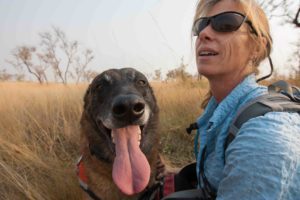 Megan Parker with Pepin, Photo: Dave Hamman
Megan Parker with Pepin, Photo: Dave HammanParker and her colleagues select dogs with an over-the-top desire to play with a toy. “The ones we choose are high speed, hell to live with, high energy, and obsessive-compulsive. They will do anything to fetch or tug.”
To train the dogs, Parker links the scent of whatever target she’s training the dog on, be it ivory, ammunition, or invasive weeds, with a reward, usually a ball or a tug toy. “All of our training is positive. We link what they love with what we want them to find.”
When they find and train the right dog, Parker says, “The dog loves it. When it loves what it’s doing and has focus and drive, we keep it busy.”
She and her colleagues train dogs that get placed in countries as far away as Zambia. These dogs are trained to detect pangolin scales, leopard skins, lion, mokula lumber, gunpowder, elephant ivory, rhino horn, illegal ammunition, and illegal bush meat species.
*****
DOG HEROES FOR CHEETAHS
The world cheetah population has dropped from 100,000 to ten thousand over the past one hundred years. While the story of their population decline is similar to that of other species across the globe one of their challenges has to do with the cheetah’s greatest asset: its speed.
A cheetah can accelerate to seventy miles per hour in just three seconds. With special claws that work like cleats; a tail used as a rudder; long limber legs; a flexible backbone; an expanded nasal cavity for greater air intake; and enlarged arteries, lungs, and heart, the cheetah is an aerodynamic wonder of unparalleled speed.
However, because they are built for speed and not for power, cheetahs have trouble competing with larger and more powerful cats that will often steal a cheetah’s prey and kill their young.
One way cheetahs have dealt with this obstacle is by living outside of game reserves where many of their competitors are found. Consequently, 90 percent of Namibia’s cheetahs reside outside of protected areas, alongside humans, many of whom are farmers that see the cheetah as competition for their livestock.
When Laurie Marker moved to Namibia to start the Cheetah Conservation Fund (CCF), her first task was to sit with farmers and to listen.
Livestock farmers had killed nearly half of Africa’s most endangered big cat, and Marker was all about finding solutions.
“The most difficult part of doing this job is balancing all of the interests of the people involved—the politics of keeping everyone happy. And with cheetahs we will not solve the conservation crisis unless all stakeholders have a voice in the solution.”
Keeping everyone happy and giving all stakeholders a voice means caring about livestock farmers (in an arid environment with regular drought, livestock farming is the main form of livelihood) whose decision to pull the trigger could mean one less endangered cat.
“You can’t ask a farmer to care about conserving wildlife when he’s struggling just to feed his family,” says Marker. That’s why one of CCF’s signature programs is Future Farmers of Africa, a human-wildlife conflict mitigation initiative. This program works with farmers to find predator-friendly livestock and wildlife management techniques.
One such technique Marker pioneered in Namibia is the use of Anatolian shepherds and Kangal dogs, physically imposing dogs originally from Turkey.
The dogs, whom Marker carefully selects, are highly intelligent, protective of the livestock, and able to drive away most large predators. Farmers who have used Anatolian and Kangal dogs to protect their herds have reported drops in predation rates of between 80 and 100 percent—meaning those farmers are less likely to kill or trap cheetahs on their lands. Farmers, in fact, are so enthusiastic about the program that there is a two-year waiting list for puppies.
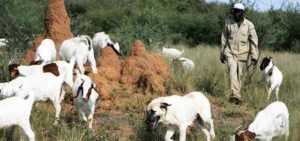 CCF guard dog at work
CCF guard dog at workExcerpts for this post were taken from the new book, Wild Lives, Leading Conservationists on the Animals and Planet They Love. Laurie Marker and Megan Parker, who are both using dogs for conservation, are two of the twenty conservationists featured in the book who are saving species across the globe.
The post Conservation’s Dog Heroes appeared first on .
September 22, 2017
VOLUNTEER FOR WILDLIFE, ANIMALS, AND CONSERVATION
Have you ever considered helping animals by signing up to volunteer for wildlife abroad? Writer Hildy Rubin put together this post for SavingWild. It is full of tips and ideas for anyone who wants to volunteer for wildlife.
There are many different ways to volunteer. You can help researchers collect data that will be used for conservation (tigers in India, desert elephants in Namibia, whales in the Azores), work in a wildlife sanctuary caring for rescued and orphaned animals (baby orangutans in Borneo), build fences, plant trees, teach students, photograph and/or count animals. The choices are vast. Some ‘volunteer for wildlife’ opportunities allow you to have close, or hands-on encounters with animals. Others might be more indirect – protecting and improving habitat, analyzing data, or working in the community to teach people and students about conservation, environmental protection, etc.
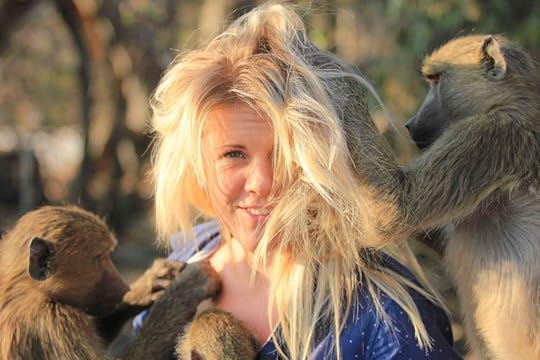 Baye Pigors. Photo from Adam Jones.
Baye Pigors. Photo from Adam Jones.Some things to be aware of before you Volunteer for Wildlife
Something that you may not be aware of – it is usually not free to volunteer for wildlife on programs abroad. Most projects charge a fee, which is used to pay for your food and accommodation, as well as other costs associated with your stay, such as transportation and donations to the project.
Tips for Choosing a Volunteer Program
Whatever project and company you get involved with, volunteering for wildlife can be an incredible experience, sometimes life-changing, while at the same time contributing to a worthwhile cause which needs your help, if you choose your project wisely. The goal is to find a project that offers you a memorable, fulfilling experience which has contributed to helping wildlife in some way. Some factors to keep in mind while choosing where you will volunteer are: Is the organization working to release the animals back into the wild? How much training will you receive? At the end of your experience will you have gained skills that will help you achieve your goals? The end result of your volunteering for wildlife should be mutually beneficial.
Helpful information
This website has some good information on the overall topic: http://edgeofafrica.com/responsible-wildlife-volunteering/
Some basic questions to consider:
What is the main goal of the organization? For example:
http://edgeofafrica.com/about-us/responsible-volunteering/
https://www.thegreatprojects.com/about-us
How does the organization use your fee/donation?
https://www.thegreatprojects.com/where-your-money-goes
How does the organization vet their projects?
Is the organization environmentally responsible? https://www.thegreatprojects.com/responsible-travel-policy
What exactly will you be doing on your project? Will you be just used for labor or will you feel like your efforts are actually contributing to conservation? A good place to find this information is through participant reviews:
https://www.thegreatprojects.com/blog/alys-review-samboja-lestari
Before getting involved and paying your fee, do your homework, ask questions, and find out everything you can about the company and the project.
Here are a few of the many places that offer volunteer with wildlife opportunities. [Please note that Saving Wild is not endorsing any of these, just offering a way for you to get started on your search.]
https://www.thegreatprojects.com/
https://www.cheetah.org/you-can-help/...
http://youth4africanwildlife.org/get-...
https://www.gooverseas.com/volunteer-...
https://conservationvip.org/why-volun...
https://www.conservationafrica.net/
http://www.wildlifevolunteer.org/
https://www.gviusa.com/volunteer-abro...
We hope this information and these tips have been helpful. Let us know in the comments below.
Whatever you choose, we wish you a wonderful and successful volunteering with wildlife experience!
The post VOLUNTEER FOR WILDLIFE, ANIMALS, AND CONSERVATION appeared first on .
July 21, 2017
How Permaculture is Saving Kenya’s Wildlife
Last year while traveling in East Africa I met an exceptional young man, permaculture practitioner George Kaberia. He is a 35 year-old Kenyan who is saving wildlife and wild places through gardening. I think you will love his story.
George works at Sirikoi, a safari lodge situated smack dab in the center of Kenya. One day, after eating yet another exceptional organic meal of berries, greens and even fresh turmeric from Sirikoi’s on-site kitchen garden, I asked if I could get a tour of the vegetable patch.
George enthusiastically leads me through an acre of land he maintains using permaculture methods. If you haven’t heard of permaculture it’s a way of gardening that takes advantage of the different characteristics of plants to produce more while using less water and no chemicals.
We walk alongside mounds of peppers, potatoes, spinach, basil, bananas, and raspberries interspersed with marigolds under the arms of avocado, mango and citrus trees. “It’s called companion planting, George explains. “Garlic chives protect carrots, and leeks protect broccoli, from aphids and white fly. The trees provide shade.”
Chickens, used for eggs and meat and manure compost, peck around our feet looking for bugs, while worms enclosed in a massive bin are eating their way through weeds and leaf scraps to make compost and ‘liquid gold’, a juice used as natural fertilizer. The idea is to “continually add beneficial fungus and bacteria to the soil as food for the plants,” says George. From the looks of the lush leaves and abundant produce, it’s working in spades.
You have to understand what a surprise this is. On a continent whose small farmers are known for single crop production (lots of bananas), and the increasingly more common practice (thanks to the USA) of using fertilizers and chemicals, having this kind of variety, and all of it organic, is novel.
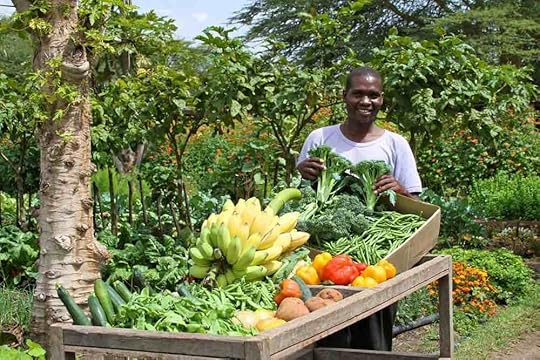
George transports produce to Sirikoi’s kitchen. Photo @Sirikoi
George first learned about permaculture while working for a non- governmental organization in 2013. “It made so much sense” that he brought the ideas home to practice on his own garden and then to Sirikoi.
George shares his permaculture gospel to anyone who will listen. With George’s help, numerous people in his home village are using his techniques in their gardens.
And now he wants his ideas to grow bigger. “My plan is to help more and more people in surrounding villages raise vegetables without chemicals and by using less water. A lot of people now have cancer because of chemicals being used on their gardens.”
He also wants to help pastoral people like the Samburu, Turkana, and Maasai to practice farming instead of relying on the government for relief food.
All of this helps save wildlife. Food insecurity is one of the main causes of bush meat poaching, and poisoned soils and plants contaminate little critters that are then eaten by larger animals, and so on, up the food chain.
For this reason, George is this years Saving Wild hero. (To see past heroes go here and here.)
With a cash contribution Saving Wild will help support George to help others have lush organic gardens to feed their families, and save wildlife all at the same time.
The best part is that one of my safari clients will be going to Sirikoi in October and can hand deliver the cash to George. Direct delivery is the best way I know of to make sure the donation gets to the actual person who will most benefit. This is grassroots support at its most effective and it’s what Saving Wild specializes in. (Remember SavingWild’s super successful on-the-ground plastic clean up program?)
If you would like to help George spread the seeds of his great work (sorry for the pun, I couldn’t help myself) you have two options:
1) Donate to our umbrella non-profit. You will get a tax deduction but a small portion will go to them for their services. Here is the donate button:

2) Send a check to me (I will cash it and add it (100%) to the envelope being delivered to George).
Feel free to contact me with any questions about permaculture, George’s plans or visiting Sirikoi.
Email me at savingwildblog@gmail.com
LvL
The post How Permaculture is Saving Kenya’s Wildlife appeared first on Saving Wild.
July 12, 2017
Unusual Final Act For Lucky Giraffe
This morning, on my last wildlife drive here at Mombo Trails, before I fly to another camp in a different area of Botswana, we come across all that remains of a dead giraffe: a sun bleached jaw-bone. The death most likely the result of a long chase, and fatal bite to the jugular. Probably from a lion. After the big cat pride had taken their fill, others – jackals, hyena, vultures – would have cleaned up the remains.
To my eye there is nothing left. But one spotted hyena disagrees. She patiently whittles away at a slimy, saliva softened patch of bone. “For much needed calcium,” Seko, my guide, says. Hyenas live in packs but she won’t announce this meal to her clan – too much effort for very little reward. We leave her be.
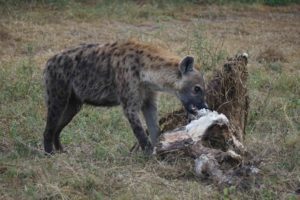
Spotted Hyena eating giraffe jaw bone.
A few minutes further along the dirt road we spot another dead giraffe. “Around 25 years of age,” according to Seko, “an old male.”
We stare at the fallen being. His stomach entrails are spilled outside of it’s cavity (possibly the work of one hyena) but otherwise the giraffe is intact.
Every day animals die here in the wild, but it’s rare to see a whole dead animal. Every animal is food to someone else, devoured quickly and completely, rarely leaving a trace.
This giraffe had died peacefully. For his entire life, and in his final weakened state of old age, he had beaten the odds. He had avoided being taken down by lions, fatally kicked by other male giraffes, or killed by bush meat poachers. Unusual for the African bush.
Instead he had laid down in this open circle of grass edged by shrubs, his long neck stretched against the earth and land he had called home for a quarter of a century, and taken his last breath.
Seko tells me he knows this giraffe. “This male was the first giraffe I learned to recognize when I started guiding in this area about eight years ago.” There’s a sadness in Seko’s voice. He has lost a friend.
I wonder who, besides Seko (and me), notice that this great giraffe being is gone? Did this guy have friends, family or loved ones? Did any of them witness his passing three days earlier?
Loneliness – for the giraffe, for myself – envelops me.
Elephants continue to visit the bones of dead family members, ritualistically mingling among the remains as a part of their process of letting go of the deceased. Do giraffes have a similar ritual?
No matter, death is a solo act.
Seko’s friend had, I imagined, lived an elegant and wonderful life before dying with peace and dignity.
That’s the best we can hope for.
Later, I wonder if the hyena we had seen had yet realized that a few minutes walk from the jaw-bone lay a whole meal for the taking – an elegant gentle giant waiting to be reintegrated into the Botswana sand and earth from which he originated.
**Every time you shop on Amazon you can help giraffes and wildlife across the globe if you use the shop Amazon link on the right of this page. Copy the link to your desk top and use it each time you shop.
The post Unusual Final Act For Lucky Giraffe appeared first on Saving Wild.
June 11, 2017
Elephants – Up Close and Personal
Elephants are like us, but better, says Daphne Sheldrick. They share consciousness and emotions, elaborate communication and memory, and family and social ties similar to our own. In fact, elephants share more attributes with us than most other animals.
It’s the main reason elephants have become the poster child of the conservation movement. “We tend to admire qualities in other species that we recognize in ourselves. [And that] makes it easier for us to relate to them. As a result, we empathize more with gorillas [and elephants] than guppies,” says wildlife filmmaker Mark Deeble.
I’ve been fortunate to see elephants in the wild many times over the 33 years I’ve been going on safari in Africa. But this time, if I could have counted them all, I estimate I saw 1,000 elephants in the three weeks I recently spent in Botswana’s Okavango Delta. That’s more elephant encounters than I’ve had on all my trips combined.
Elephants are a keystone species. Trees and plants, whose seeds are spread in their manure, support hundreds of different types of animals.
Elephants rule Africa’s land.
As a humble visitor here I am grateful to them for every encounter. To hear their rumbling communication when calling each other closer, their trumpeting protests, and the flapping of their ears when they are telling us we have come close enough.
I rejoice in their obvious joy as they rush down the sandy hill towards water where they play, swim, submerge themselves, and drink.
Wild elephants visited my tent at 5 of the camps I stayed in. And they sniffed me, lifting their trunks towards the back of the safari vehicle where I sat silently. A few of them stopped eating or walking, turning to stare at me. I wish I knew what they were thinking.
At dusk a herd of about 100 elephants surrounded me and my driver/guide. We spent an hour with them watching adolescents jostle each other, and one brave guy repeatedly sniff and mock charge our open topped truck. Anyone of them could have easily flipped our vehicle. But they tolerated us.
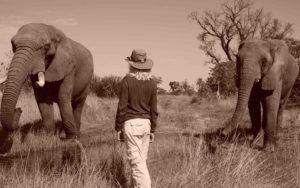
Me with Jabu and Morula.
On a visit to the Living With Elephants Foundation I met Jabu and Morula, two human-habituated elephants. I stroked their wrinkled leathery skin and wiry tail, looked inside their mouths, and supported their heavy trunks across my shoulder. They trumpeted, squirted water, and kissed me. I learned elephant facts from their owners as I walked alongside them through the water laden lands they call home.
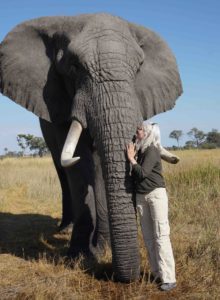
Me with Jabu.
Of all the amazing things I understand about elephants, what remains with me is the feeling I experience whenever I am in their presence. They exude a powerful but gentle energy. They are strong and independent, yet comforting and caring. They seem to be present, and highly aware of each other, their surroundings, and me. It’s how I feel in the company of a spiritual guru. Or similar to how I felt years ago when I touched a wild baby whale in Mexico’s San Ignacio Lagoon as she maneuvered her body towards me to look deep into my eyes. One soul acknowledging another soul. The contact was so powerful I cried. That’s how I feel being among the elephants. There is a wordless harmony, as if I’ve found a missing piece of myself.
Each and every day there are about 100 less elephants than there were the day before. Ivory poaching has drastically cut their numbers from an estimated 10 million in the 1900’s to about 35,000 today.
In Carl Safina’s book, Beyond Words, he explains why ivory poaching is so difficult to terminate. “Ivory is about poverty, ethnic rivalry, terrorism, and civil war. Orchestrating much of this are…- criminals, corrupt government officials, official governments – who are mining elephant populations to finance savage conflict. …Blood ivory has been helping finance Joseph Kony’s Lords Resistance Army, Sudan’s murderous Janjaweed, and possibly Al Queda’s Al Shabab wing. Fueling all this is simple consumer craving for carvings that people could – quite literally – live without. So ivory is not just about elephants. It would be far simpler if it were.“
Elephants represent wild Africa like no other species. Safina says, “In a generation or two, the memory of wild Africa will be lost as utterly as an American prairie of head-high wildflowers swirled by bison, darkened by wild pigeons, bordered by towering forests of chestnuts, as it all was, mere moments ago.”
Safina’s words create panic in my heart. Without wild elephants in the world I will die from a great loneliness of spirit, for whatever happens to elephants, also happens to me.
The post Elephants – Up Close and Personal appeared first on Saving Wild.

